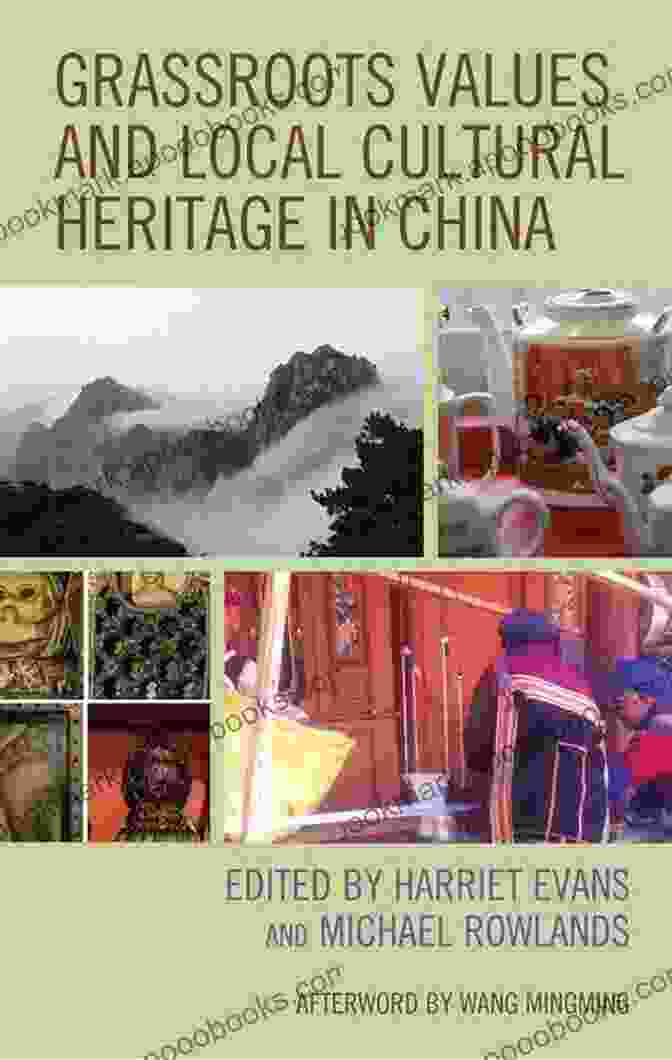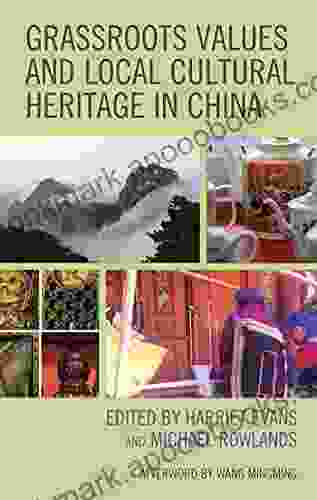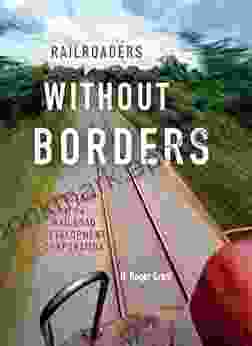Grassroots Values and Local Cultural Heritage in China: A Journey into the Heart of the Countryside

China, a land of ancient civilizations and diverse cultures, possesses a rich tapestry of grassroots values and local cultural heritage that extend far beyond the bustling metropolises. In the sprawling countryside, where traditions and customs have been passed down through generations, lies a treasure trove of intangible cultural heritage that defines the very essence of Chinese identity.
This comprehensive article will embark on a journey into the heart of rural China, uncovering the hidden treasures of grassroots values and local cultural heritage that shape the lives of its people. From the vibrant festivals and rituals to the unique crafts and folklore, we will explore the diverse expressions of cultural heritage that continue to thrive in the countryside.
4.4 out of 5
| Language | : | English |
| File size | : | 8799 KB |
| Text-to-Speech | : | Enabled |
| Screen Reader | : | Supported |
| Enhanced typesetting | : | Enabled |
| Word Wise | : | Enabled |
| Print length | : | 282 pages |
Grassroots Values: The Foundation of Rural Communities
At the core of rural Chinese communities lies a set of deeply rooted grassroots values that guide the daily lives and interactions of its people. These values, often passed down through oral traditions and communal practices, serve as the foundation of social cohesion and cultural identity.

Among the most prominent grassroots values is the emphasis on filial piety, the deep respect and care for one's parents and ancestors. This value is reflected in family-oriented traditions such as ancestor worship and the veneration of elders.
Another fundamental grassroots value is harmony and коллективизм. Rural communities in China prioritize the collective well-being over individual interests, fostering a sense of belonging and cooperation. This value is evident in the communal labor practices, such as the sharing of resources and the collective decision-making through village councils.
Respect for nature is also deeply ingrained in grassroots values. Rural communities have a close connection to the land and its resources, which are seen as essential for their livelihoods. Traditional practices such as feng shui and the veneration of nature spirits reflect the deep respect and reverence for the natural world.
Local Cultural Heritage: A Tapestry of Diversity
The local cultural heritage of rural China is as diverse as its vast landscape, ranging from traditional festivals and rituals to unique crafts and folklore. These diverse expressions of cultural heritage play a vital role in preserving the identity and traditions of local communities.

Traditional festivals are a vibrant part of rural life, providing opportunities for communities to come together and celebrate their shared cultural heritage. These festivals, often linked to seasonal changes or agricultural cycles, are marked by colorful ceremonies, folk performances, and communal feasts.
Rituals and customs are another important aspect of local cultural heritage. These practices are imbued with deep symbolism and beliefs, and they serve to regulate social and religious life within communities. Ancestors rituals, weddings, and funerals are just a few examples of the many rituals that continue to be observed in rural China.
Traditional crafts, such as pottery, weaving, and embroidery, are not only essential for daily life but also serve as expressions of artistic creativity. These crafts are often passed down through generations, preserving the unique skills and techniques that have been developed over centuries.
Folklore, in the form of stories, legends, and proverbs, plays a crucial role in transmitting cultural values and traditions from one generation to the next. These stories often reflect the wisdom and experiences of the local people, providing insights into the history and culture of their community.
Preserving and Reviving Cultural Heritage
In recent years, there has been a growing recognition of the importance of preserving and reviving cultural heritage in rural China. As urbanization and modernization continue to transform the countryside, it is vital to safeguard the diverse traditions and customs that have shaped these communities for centuries.

Government initiatives and community-based programs are playing a crucial role in preserving cultural heritage. These initiatives include the establishment of cultural heritage parks, the documentation of traditional crafts and rituals, and the promotion of cultural tourism.
Local communities are also actively involved in the preservation and revival of their cultural heritage. They organize workshops, festivals, and other events to pass on traditional knowledge and skills to younger generations. By actively engaging in the preservation of their heritage, rural communities are ensuring that future generations can continue to appreciate and benefit from the rich cultural tapestry of China.
The grassroots values and local cultural heritage of rural China are an invaluable treasure that enriches the lives of its people and contributes to the vibrant diversity of Chinese culture. From the deeply rooted values of filial piety and harmony to the diverse expressions of festivals, rituals, crafts, and folklore, these traditions and customs define the very essence of Chinese identity.
Preserving and reviving cultural heritage is not merely about safeguarding the past but also about ensuring the vitality of rural communities and the cultural identity of the Chinese people. By embracing and celebrating the grassroots values and local cultural heritage of the countryside, we not only honor the legacy of our ancestors but also create a rich and meaningful future for generations to come.
4.4 out of 5
| Language | : | English |
| File size | : | 8799 KB |
| Text-to-Speech | : | Enabled |
| Screen Reader | : | Supported |
| Enhanced typesetting | : | Enabled |
| Word Wise | : | Enabled |
| Print length | : | 282 pages |
Do you want to contribute by writing guest posts on this blog?
Please contact us and send us a resume of previous articles that you have written.
 Book
Book Novel
Novel Page
Page Chapter
Chapter Text
Text Story
Story Genre
Genre Reader
Reader Library
Library Paperback
Paperback E-book
E-book Magazine
Magazine Newspaper
Newspaper Paragraph
Paragraph Sentence
Sentence Bookmark
Bookmark Shelf
Shelf Glossary
Glossary Bibliography
Bibliography Foreword
Foreword Preface
Preface Synopsis
Synopsis Annotation
Annotation Footnote
Footnote Manuscript
Manuscript Scroll
Scroll Codex
Codex Tome
Tome Bestseller
Bestseller Classics
Classics Library card
Library card Narrative
Narrative Biography
Biography Autobiography
Autobiography Memoir
Memoir Reference
Reference Encyclopedia
Encyclopedia Edward S Shapiro
Edward S Shapiro Ginny Owens
Ginny Owens Lili Plume
Lili Plume Durian Sukegawa
Durian Sukegawa Jo Beverley
Jo Beverley John Srdjan Petrovic
John Srdjan Petrovic Graeme Hall
Graeme Hall Paul Irwing
Paul Irwing Lucy Kyan
Lucy Kyan Edouard Morena
Edouard Morena James Swallow
James Swallow Sam Thomas
Sam Thomas John Mcgann
John Mcgann Mark Hatala
Mark Hatala Paul Buyer
Paul Buyer Kirsten Gillibrand
Kirsten Gillibrand Mark Van Clay
Mark Van Clay Edward Bulwer Lytton Lytton
Edward Bulwer Lytton Lytton Richard Plass
Richard Plass Lindsay Price
Lindsay Price
Light bulbAdvertise smarter! Our strategic ad space ensures maximum exposure. Reserve your spot today!

 Craig CarterMoorland Hanging: The Last Templar Mysteries - A Thrilling Historical Mystery
Craig CarterMoorland Hanging: The Last Templar Mysteries - A Thrilling Historical Mystery
 Caleb LongMaster the Skies: Your Comprehensive Guide to Commercial Pilot Practical Test...
Caleb LongMaster the Skies: Your Comprehensive Guide to Commercial Pilot Practical Test... Holden BellFollow ·19.2k
Holden BellFollow ·19.2k George MartinFollow ·12.4k
George MartinFollow ·12.4k Kendall WardFollow ·10.6k
Kendall WardFollow ·10.6k Francisco CoxFollow ·2.3k
Francisco CoxFollow ·2.3k Cade SimmonsFollow ·11.4k
Cade SimmonsFollow ·11.4k Isaac BellFollow ·12.4k
Isaac BellFollow ·12.4k Roger TurnerFollow ·6.5k
Roger TurnerFollow ·6.5k Carl WalkerFollow ·14.5k
Carl WalkerFollow ·14.5k

 Eugene Powell
Eugene PowellFat Cat Stories: Level At Word Family - A Purrfect Start...
Introducing the 'At'...

 William Powell
William PowellUnveiling the Treasures of Russian Poetry: The Cambridge...
Immerse yourself in the...

 Roberto Bolaño
Roberto BolañoUnveiling the Treasures of Beowulf: A Guided Tour with...
: Delving into the...

 Foster Hayes
Foster HayesTransport, Climate Change and the City: Tackling Urban...
Transport is a major...

 Calvin Fisher
Calvin FisherHow To Make It In The Music Industry: The Ultimate Guide...
Are you an aspiring musician with...

 Rick Nelson
Rick NelsonUnveiling the Enigmatic World of Gary Chester's "The New...
Step into a World...
4.4 out of 5
| Language | : | English |
| File size | : | 8799 KB |
| Text-to-Speech | : | Enabled |
| Screen Reader | : | Supported |
| Enhanced typesetting | : | Enabled |
| Word Wise | : | Enabled |
| Print length | : | 282 pages |








